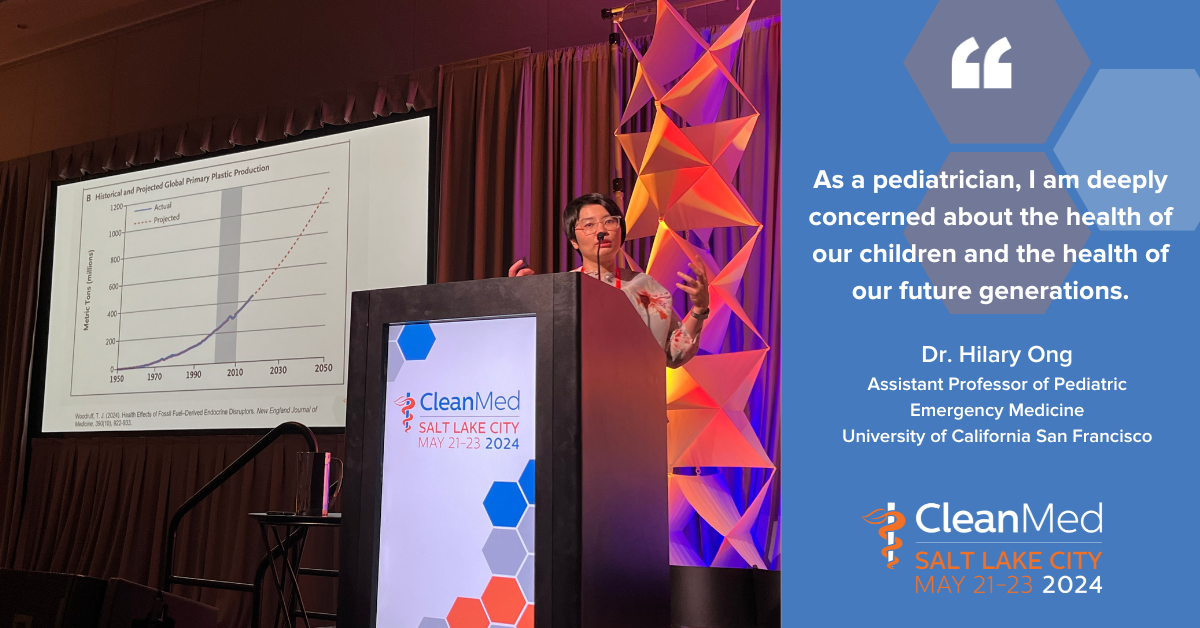Plastic pollution has emerged as one of the most pressing environmental challenges of our time — with far-reaching implications for human health and the planet. While various industries contribute to this crisis, the health care sector is also a significant contributor to plastic pollution, contrary to its healing mission.
In my everyday clinical work as a pediatric emergency medicine physician, I use and dispose of too many single-use plastic materials, often unnecessary for clinical care, and witness hospitals’ deep dependence on plastic products.

Tackling the plastic crisis and identifying innovative clinical solutions
A panel, including Dr. Ong, led a rich discussion at CleanMed 2024 which made it clear that while reducing health care plastic use can be effectively addressed at the bedside, hospital systems must leverage their group purchasing power to stock fewer single-use plastic-based products and prioritize PVC-free and phthalate-free medical equipment.
Health care’s plastic impact: A growing concern
The health care industry relies heavily on plastic materials due to their low cost, durability, flexibility, and sterility. From single-use syringes to intricate medical devices, plastic has become ever-present in modern health care practices. In the U.S., 20% to 25% of the 14,000 tons of waste generated daily by hospitals is plastic.
The reliance on plastic comes at a steep cost to public and environmental health because its production significantly contributes to the climate crisis. The global production of primary plastics reached 368 million metric tons and generated 5.3% of total global GHG emissions in 2019. In a business-as-usual scenario, plastic production and its related emissions are expected to double or triple by 2050.
The production and disposal of plastics release numerous harmful chemicals into the environment. Over 13,000 chemicals are associated with plastics and plastic production. These chemicals leach into the environment, contaminating soil, water, and air, with repercussions for human health.
Position statement: A problematic plastic
Learn more about why health care should avoid products made with PVC and the additive DEHP and research safer alternatives.
Plastic pollution’s impact on health: The hidden toll
Plastic is everywhere. We are exposed to all forms of plastics through the food we eat, the water we drink, the air we breathe, and the products we put on our skin — but people don’t often think about the plastics we are exposed to in a health care setting.
Health care products often contain plasticizers, which are chemicals added to plastics to increase their flexibility, durability, and longevity. Commonly used plasticizers in medical products include phthalates, such as DEHP, and other substances like BPA. While these chemicals improve the functionality of medical devices, they can also pose significant health risks.
Studies have linked exposure to plastic-derived chemicals with various adverse health outcomes, including infertility, congenital disorders, diabetes, asthma, coronary heart disease, and increased cancer risk — leading to 1.8 million deaths each year globally. Endocrine disruptors, like BPA and phthalates, interfere with hormone function, leading to reproductive issues, developmental delays, and increased cancer risks. Plastics do not decompose — they only degrade into tinier particles. Microplastics and nanoplastics have become ever-present in our environment and are increasingly recognized as a significant health hazard. Microplastics have been found in multiple organ systems including our bloodstream, lungs, gastrointestinal tract, brain, placenta, breastmilk, and testicles. While the long-term health impacts of micro and nanoplastics are still being studied, it is known they can cause oxidative stress at the cellular level, leading to cellular damage and inflammatory responses. Micro and nanoplastics can also continue to leach toxic chemicals that act as endocrine disruptors.
As the prevalence of plastic pollution continues to rise, so will its toll on public health, underscoring the urgent need for intervention.
The economic toll of plastic pollution is equally concerning. It is estimated that health care costs incurred by plastic-associated disease in the U.S. reached a staggering $249 billion in 2018 alone. This encompasses health care expenditures related to treating plastic-induced health conditions as well as the broader societal costs of lost productivity and diminished quality of life.
Pioneering solutions: Reducing health care plastic reliance & waste
While the challenges posed by health care plastic pollution are daunting, a growing movement exists toward sustainable and safe alternatives and innovative solutions. Key stakeholders, including health care professionals, manufacturers, and policymakers, are increasingly recognizing the imperative to reduce plastic reliance and minimize plastic waste generation.
In the process of providing patient care, clinicians frequently use a variety of single-use plastic supplies and materials, often due to the lack of non-plastic alternatives. As a clinician, I see the crucial role we play in reducing health care plastic pollution by critically evaluating diagnostic testing practices and tailoring treatments for every patient. This not only maximizes patient outcomes and satisfaction but also minimizes cost and waste.
I recently concluded an unpublished research study revealing that 75% of single-use materials in laceration repair kits were unused by our pediatric emergency medicine clinicians, resulting in significant waste. Most of these unused materials are plastic-based. Clinicians participating in the study identified that only four out of the 17 items in the kits were necessary. By using only the essential items, we could potentially reduce our current waste by approximately 70%. This reduction is equivalent to reducing 50% of our annual greenhouse gas emissions from laceration repair procedures alone.
As frontline health care providers, clinicians are at the forefront of the plastics and climate crises. Clinicians play a pivotal role in advocating for and implementing sustainability initiatives within the health care sector. They can drive significant change toward more sustainable practices by encouraging procurement and supply chain leaders to choose medical products with safer chemicals or non-plastic alternatives.
I co-led a session at CleanMed 2024, “Tackling the plastic crisis: Identifying innovative clinical solutions,” this May. The rich discussion made it clear that while reducing health care plastic use can be effectively addressed at the bedside, hospital systems must leverage their group purchasing power to stock fewer single-use plastic-based products and prioritize PVC-free and phthalate-free medical equipment. With supply and demand increased, medical equipment and supplies manufacturers that value planetary health will have an increase in market penetration of their sustainable products.
Toward a sustainable health care future
We are facing a global plastic crisis, and it is becoming increasingly evident that plastic pollution is causing numerous human health issues and diseases, and contributing to the climate crisis. A global, United Nations-led Plastic Treaty was created to hold plastic manufacturers and countries accountable. Regulations must be in place to curb plastic production and waste disposal and negotiations are underway.
Alongside multiple health care organizations representing over 6 million health professionals in 73 countries globally, I signed a letter to urge UN delegates to develop an ambitious and just treaty to end plastic pollution, ensuring the health sector is included. This requires special considerations to maintain innovation and momentum in plastic reduction, reuse, and redesign. The effort, led by Health Care Without Harm, called for:
- A just and equitable treaty that respects human rights
- Limits on plastic production
- The elimination of unnecessary plastic products, including single-use plastics
- Detoxification and transparency of plastic products and materials, providing health professionals with the information they need to understand the chemicals in the products they use to treat patients
In confronting the complex challenge of health care plastic pollution, collective action and innovation are paramount. Work in health care sustainability is challenging, but I join hands with my colleagues across Health Care Without Harm to engage in this work for my patients, my family, and our planet.

Dr. Hilary Ong (she/her) is a physician and assistant professor of pediatric emergency medicine at Benioff Children’s Hospital at University of California San Francisco. She was one of the recipients of Health Care Without Harm’s inaugural Emerging Physician Leader Award in 2019. Her research and academic interests are in waste reduction and decarbonization in the emergency department and adaptation and climate disaster preparedness for pediatrics.